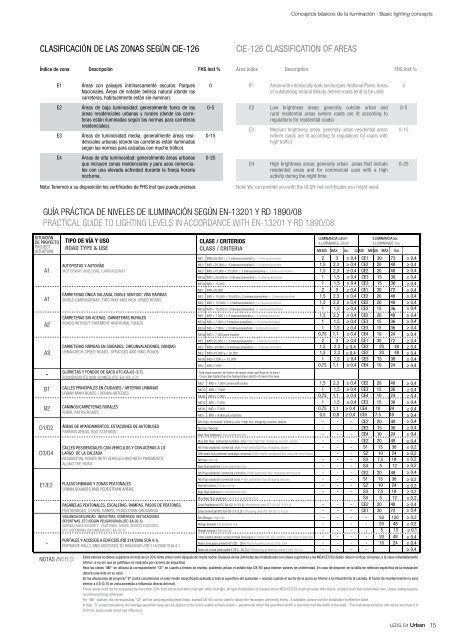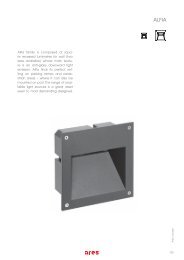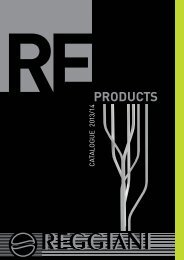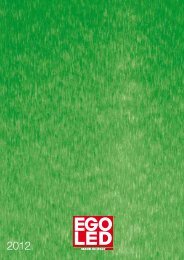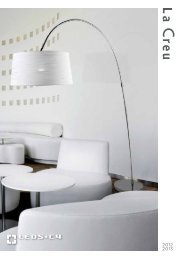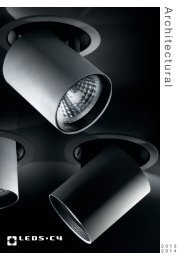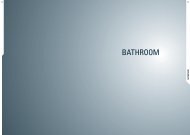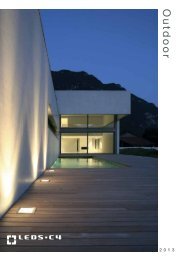You also want an ePaper? Increase the reach of your titles
YUMPU automatically turns print PDFs into web optimized ePapers that Google loves.
Conceptos básicos de la iluminación · Basic lighting concepts<br />
CLASIFICACIÓN DE LAS ZONAS SEGÚN CIE-126<br />
CIE-126 CLASSIFICATION OF AREAS<br />
Índice de zona Descripción FHS Inst %<br />
Area index Description FHS Inst %<br />
E1<br />
Áreas con paisajes intrínsecamente oscuros: Parques<br />
Nacionales, Áreas de notable belleza natural (donde las<br />
carreteras, habitualmente están sin iluminar).<br />
0<br />
E1<br />
Areas with intrinsically dark landscapes: National Parks. Areas<br />
of outstanding natural beauty (where roads tend to be unlit)<br />
0<br />
E2<br />
E3<br />
Áreas de baja luminosidad: generalmente fuera de las<br />
áreas residenciales urbanas y rurales (donde las carreteras<br />
están iluminadas según las normas para carreteras<br />
residenciales).<br />
Áreas de luminosidad media: generalmente áreas residenciales<br />
urbanas (donde las carreteras están iluminadas<br />
según las normas para calzadas con mucho tráfico).<br />
0-5<br />
0-15<br />
E2<br />
E3<br />
Low brightness areas: generally outside urban and<br />
rural residential areas (where roads are lit according to<br />
regulations for residential roads)<br />
Medium brightness areas: generally urban residential areas<br />
(where roads are lit according to regulations for roads with<br />
high traffic)<br />
0-5<br />
0-15<br />
E4<br />
Áreas de alta luminosidad: generalmente áreas urbanas<br />
que incluyen zonas residenciales y para usos comerciales<br />
con una elevada actividad durante la franja horaria<br />
nocturna.<br />
0-25<br />
E4<br />
High brightness areas: generally urban areas that include<br />
residential areas and for commercial uses with a high<br />
activity during the night time.<br />
0-25<br />
Nota: Tenemos a su disposición los certificados de FHS Inst que pueda precisar.<br />
Note: We can provide you with the ULOR Inst certificates you might need.<br />
GUÍA PRÁCTICA DE NIVELES DE ILUMINACIÓN SEGÚN EN-13201 Y RD 1890/08<br />
PRACTICAL GUIDE To LIGhTING LEVELS IN ACCoRDANCE wITh EN-13201 Y RD 1890/08<br />
SITUACIÓN<br />
DE PROYECTO<br />
PROJECT<br />
SITUATION<br />
A1<br />
A1<br />
A2<br />
A3<br />
-<br />
GLORIETAS Y FONDOS DE SACO (ITC-EA-02-3.7).<br />
ROUNDABOUTS AND SIDINGS (ITC-EA-02-3.7).<br />
B1<br />
B2<br />
D1/D2<br />
D3/D4<br />
E1/E2<br />
-<br />
NOTAS /NOTES:<br />
TIPO DE VÍA Y USO<br />
ROAD TYPE & USE<br />
AUTOPISTAS Y AUTOVÍAS<br />
MOTORWAY AND DUAL CARRIAGEWAY<br />
CARRETERAS ÚNICA CALZADA, DOBLE SENTIDO, VÍAS RÁPIDAS<br />
SINGLE CARRIAGEWAY, TWO-WAY AND HIGH-SPEED ROADS<br />
CARRETERAS SIN ACERAS, CARRETERAS RURALES<br />
ROADS WITHOUT PAVEMENT AND RURAL ROADS<br />
CARRETERAS RÁPIDAS EN CIUDADES, CIRCUNVALACIONES, RONDAS<br />
URBAN HIGH-SPEED ROADS, BYPASSES AND RING-ROADS<br />
CALLES PRINCIPALES EN CIUDADES / ARTERIAS URBANAS<br />
URBAN MAIN ROADS / URBAN ARTERIES<br />
CAMINOS/CARRETERAS RURALES<br />
RURAL PATHS/ROADS<br />
ÁREAS DE APARCAMIENTOS, ESTACIONES DE AUTOBUSES<br />
PARKING AREAS, BUS STATIONS<br />
CALLES RESIDENCIALES CON VEHÍCULOS Y CON ACERAS A LO<br />
LARGO DE LA CALZADA<br />
RESIDENTIAL ROADS WITH VEHICLES AND WITH PAVEMENTS<br />
ALONG THE ROAD<br />
PLAZAS URBANAS Y ZONAS PEATONALES<br />
URBAN SQUARES AND PEDESTRIAN AREAS<br />
PASARELAS PEATONALES, ESCALERAS, RAMPAS, PASOS DE PEATONES<br />
FOOTBRIDGES, STAIRS, RAMPS, PEDESTRIAN CROSSINGS<br />
VIGILANCIA/SEGURIDAD: INDUSTRIAS, COMERCIOS, INSTALACIONES<br />
DEPORTIVAS, ETC (SEGÚN PELIGROSIDAD).(ITC-EA-02-5)<br />
SURVEILLANCE/SECURITY: FACTORIES, SHOPS, SPORTS FACILITIES,<br />
ETC (DEPENDING ON DANGER).(ITC-EA-02-5)<br />
PORTALES Y ACCESOS A EDIFICIOS (RD 314/2006 SUA 4.1)<br />
ENTRANCE HALLS AND ACCESSES TO BUILDINGS (RD 314/2006 SUA 4.1<br />
LUMINANCIA cd/m²<br />
ILLUMINANCE cd/m²<br />
ILUMINANCIA lux<br />
ILLUMINANCE lux<br />
CLASE / CRITERIOS<br />
CLASS / CRITERIA<br />
MEDIA MÁX Uo. CLASE MEDIA MÁX Um.<br />
ME1 IMD>25,000 ( ≥ 3 intersecciones/km) (≥ 3 intersections/km)<br />
ME2 IMD >25,000 (< 3 intersecciones/km) (< 3 intersections/km)<br />
ME2 IMD >15,000 < 25,000 ( ≥ 3 interseciones/km) (≥ 3 intersections/km)<br />
ME3a IMD < 25,000 (< 3 intersecciones/km) (< 3 intersections/km)<br />
ME3a IMD < 15,000<br />
ME1 IMD>25,000<br />
ME2 IMD > 15,000 < 25,000 (< 3 intersecciones/km) (< 3 intersections/km)<br />
ME2 IMD < 15,000 ( ≥ 3 interseciones/km) (≥ 3 intersections/km)<br />
ME3a IMD < 15,000 (< 3 intersecciones/km) (< 3 intersections/km)<br />
ME2 IMD > 7,000 ( ≥ 3 interseciones/km) (≥ 3 intersections/km)<br />
ME3a IMD > 7,000 (25,000 ( ≥ 3 interseciones/km) (≥ 3 intersections/km)<br />
2 3 ≥ 0,4 CE1 30 72 ≥ 0,4<br />
ME2 IMD> 25,000 (15,000 y < 25,000 1,5 2,3 ≥ 0,4 CE2 20 48 ≥ 0,4<br />
ME3b IMD>7,000 y < 15,000 1 1,5 ≥ 0,4 CE3 15 36 ≥ 0,4<br />
ME4 IMD 7,000 comercial/turístico 1,5 2,3 ≥ 0,4 CE2 20 48 ≥ 0,4<br />
ME3C IMD > 7,000 1 1,5 ≥ 0,4 CE3 15 36 ≥ 0,4<br />
ME4b IMD < 7,000 0,75 1,1 ≥ 0,4 CE4 10 24 ≥ 0,4<br />
ME3C IMD > 7,000 1 1,5 ≥ 0,4 CE3 15 36 ≥ 0,4<br />
ME4b IMD < 7,000 0,75 1,1 ≥ 0,4 CE4 10 24 ≥ 0,4<br />
ME5 IMD < 4,000 poco tránsito 0,5 0,8 ≥ 0,4 CE5 7,5 18 ≥ 0,4<br />
Alto flujo, comercial, turístico, ocio / High flux, shopping, tourism, leisure - - - CE2 20 48 ≥ 0,4<br />
Normal / Normal - - - CE3 15 36 ≥ 0,4<br />
Bajo flujo peatonal / Low pedestrian flux - - - CE4 10 24 ≥ 0,4<br />
Muy alto flujo: comercial, turístico, ocio / Very high flux: shopping, tourism, leisure - - - CE2 20 48 ≥ 0,4<br />
Alto flujo peatonal: comercial, ocio / High pedestrian flux: shopping, leisure - - - S1 15 36 ≥ 0,2<br />
≥ 0,2<br />
≥ 0,2<br />
≥ 0,2<br />
≥ 0,4<br />
Alto/medio flujo peatonal: zona algo comercial / High/medium pedestrian flux: area with some shops - - S2 10 24<br />
Normal / Normal - - - S3 7,5 18<br />
Bajo flujo peatonal / Low pedestrian flux - - - S4 5 12<br />
Alto flujo peatonal, comercial y turístico / High pedestrian flux, shopping and tourism - - - CE2 20 48<br />
Alto flujo peatonal (comercial-ocio) / High pedestrian flux (shopping-leisure) - - - S1 15 36 ≥ 0,2<br />
Normal urbano / Urban normal - - - S2 10 24 ≥ 0,2<br />
Bajo flujo peatonal / Low pedestrian flux - - - S3 7,5 18 ≥ 0,2<br />
Muy Bajo flujo peatonal / Very low pedestrian flux S4 5 12 ≥ 0,2<br />
Zona Residencial (ITC-EA-02-3.1/3,3) / Residential area (ITC-EA-02-3.1/3,3)<br />
Zona Comercial (ITC-EA-02-3.1/3,3) / Shopping area (ITC-EA-02-3.1/3,3)<br />
-<br />
-<br />
-<br />
-<br />
-<br />
-<br />
CE2<br />
CE1<br />
20<br />
30<br />
48<br />
72<br />
≥ 0,4<br />
≥ 0,4<br />
Alto Riesgo / High risk - - - - 50 120 ≥ 0,2<br />
Riesgo Elevado / Substantial risk - - - - 20 48 ≥ 0,2<br />
Riesgo normal / Normal risk - - - - 5 13 ≥ 0,1<br />
Portal, pasillos abiertos, acceso principal zona segura / Entrance hall, open corridors, main access to safe area - - - - 20 48 ≥ 0,4<br />
Resto zona aparcamiento D1/D2: CE4 / Rest of parking area D1/D2: CE4 - - - - 10 24 ≥ 0,4<br />
Resto de zonas peatonales E1/E2: S2-S4 / Remaining pedestrian areas E1/E2: S2-S4 - - - -<br />
≥ 0,4<br />
Estos valores no deben superarse en más de un 20% tanto antes como después de media noche. Después de las 24h todas las instalaciones con clases superiores a las ME4/CE5/S3 deben reducir su flujo, al menos, a la clase inmediatamente<br />
inferior, a no ser que se justifique no realizarlo por razones de seguridad.<br />
Para las clases “ME” se utilizará la correspondiente “CE” en cuanto a límites de niveles, pudiendo utilizar el asfalto tipo CIE-R3 para obtener valores de uniformidad. En caso de disponer de la tabla de reflexión específica de la instalación<br />
deberá usar ésta en su caso.<br />
En las situaciones de proyecto “D” podrá considerarse el valor medio especificado aplicado a toda la superficie útil (calzadas + aceras) cuando el ancho de la acera es inferior a la mitad del de la calzada. El factor de mantenimiento no será<br />
inferior a 0,8 (0,75 en zona sometida a influencia directa del mar).<br />
These levels must not be surpassed by more than 20% both before and after midnight. After midnight, all light installations of classes above ME4/CE5/S3 must decrease their flux to, at least, one class below their own, unless safety reasons<br />
recommend doing otherwise.<br />
For "ME" classes, the corresponding "CE" will be used regarding level limits; asphalt CIE-R3 can be used to obtain the necessary uniformity levels. If available, please use the installation's reflection table.<br />
In type "D" project situations, the average specified value can be applied to the entire usable surface (roads + pavements) when the pavement width is less than half the width of the road. The maintenance factor will not be less than 0.8<br />
(0.75 for areas under direct sea influence).<br />
LEDS-C4 Urban<br />
15


